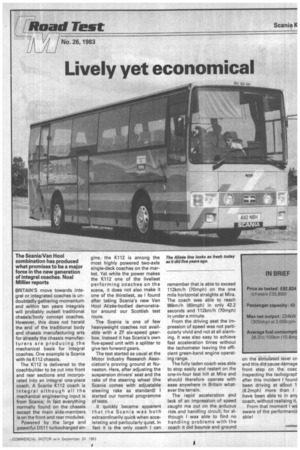ilload Test Scania K
Page 35

If you've noticed an error in this article please click here to report it so we can fix it.
Lively yet economica
BRITAIN'S move towards integral or integrated coaches is undoubtedly gathering momentum and within ten years integrals will probably outsell traditional chassis/body concept coaches. However, this does not herald the end of the traditional body and chassis manufacturing arts for already the chassis manufacturers are producing the mechanical basis for integral coaches. One example is Scania with its K112 chassis.
The K112 is delivered to the coachbuilder to be cut into front and rear sections and incorporated into an integral one-piece coach. A Scania K112 coach is integral although all the mechanical engineering input is from Scania; in fact everything normally found on the chassis except the main side-members is on the front and rear modules.
Powered by the large and powerful DS11 turbocharged en gine, the K112 is among the most highly powered two-axle single-deck coaches on the market. Yet while the power makes the K112 one of the liveliest performing coaches on the scene, it does not also make it one of the thirstiest, as I found after taking Scania's new Van Hoot Alizee-bodied demonstrator around our Scottish test route.
The Scania is one of few heavyweight coaches not available with a ZF six-speed gearbox. Instead it has Scania's own five-speed unit with a splitter to give ten forward gears.
The test started as usual at the Motor Industry Research Association's proving ground at Nuneaton. Here, after adjusting the suspension drivers' seat and the rake of the steering wheel (the Scania comes with adjustable steering rake as standard) I started our normal programme of tests.
It quickly became apparent that the Scania was both extraordinarily quick when accelerating and particularly quiet. In fact it is the only coach I can remember that is able to exceed 112km/h (70mph) on the one mile horizontal straights at Mira. The coach was able to reach 96km/h (60mph) in only 42.2 seconds and 112km/h (70mph) in under a minute.
From the driving seat the impression of speed was not particularly vivid and not at all alarming. It was also easy to achieve fast acceleration times without the tachometer leaving the efficient green-band engine operating range.
The fully laden coach was able to stop easily and restart on the one-in-four test hill at Mira and should therefore operate with ease anywhere in Britain whatever the terrain.
The rapid acceleration and lack of an impression of speed caught me out on the arduous ride and handling circuit, for although I was able to find no handling problems with the coach it did bounce and ground
























































































































